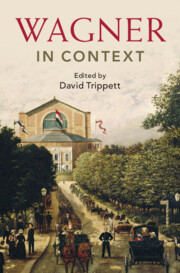Book contents
- Wagner in Context
- Composers in Context
- Wagner in Context
- Copyright page
- Contents
- Illustrations
- Musical Examples
- Contributors
- Acknowledgements
- Abbreviations
- Introduction
- I Place
- II People
- III Politics, Ideas, and Bodies
- IV Life, Language, and the Ancient World
- V Music and Performance
- VI Reception
- Chapter 35 Regietheater in Performance
- Chapter 36 Twentieth-Century Reception and Anti-Semitism
- Chapter 37 Bayreuth as Idea: Chamberlain, Wolzogen, Hitler
- Chapter 38 Performing Wagner in Israel: An Affront or a Tribute?
- Chapter 39 Nineteenth-Century Music Criticism
- Chapter 40 Wotan’s Stormtroopers and the Total Art Machine: Kittler’s Ring of the Nibelung
- Chapter 41 Sound Recording
- Chapter 42 The Wagnerian Erotics of Video Game Music
- Further Reading
- Select Bibliography
- Index
Chapter 41 - Sound Recording
from VI - Reception
Published online by Cambridge University Press: 14 March 2024
- Wagner in Context
- Composers in Context
- Wagner in Context
- Copyright page
- Contents
- Illustrations
- Musical Examples
- Contributors
- Acknowledgements
- Abbreviations
- Introduction
- I Place
- II People
- III Politics, Ideas, and Bodies
- IV Life, Language, and the Ancient World
- V Music and Performance
- VI Reception
- Chapter 35 Regietheater in Performance
- Chapter 36 Twentieth-Century Reception and Anti-Semitism
- Chapter 37 Bayreuth as Idea: Chamberlain, Wolzogen, Hitler
- Chapter 38 Performing Wagner in Israel: An Affront or a Tribute?
- Chapter 39 Nineteenth-Century Music Criticism
- Chapter 40 Wotan’s Stormtroopers and the Total Art Machine: Kittler’s Ring of the Nibelung
- Chapter 41 Sound Recording
- Chapter 42 The Wagnerian Erotics of Video Game Music
- Further Reading
- Select Bibliography
- Index
Summary
The technical limitations of early recording technologies did not deter the nascent gramophone industry from attempting to capture on cylinders the great Wagner singers of the late nineteenth century. As recording technologies improved, with inventions such as the microphone, magnetic tape, the long-playing record, and stereophonic sound, more Wagner, at greater length, was committed to disc and broadcast on the radio. Performance history can be traced through recordings: from who sang what where, to stylistic choices. Yet recordings have also shaped performance styles over time, with certain voices proving more easily reproducible than others and editing enabling a technical perfection rarely attainable live on stage. Listening to Wagner on headphones as one walks through a city or rides a train is far removed from making a pilgrimage to a production at the Bayreuth Festspielhaus.
Keywords
- Type
- Chapter
- Information
- Wagner in Context , pp. 412 - 420Publisher: Cambridge University PressPrint publication year: 2024

